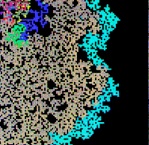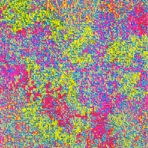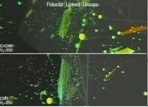IBM Research
During my work at the IBM Almaden Research Center in San Jose, California, I helped to build up a center of competence for data visualization. I collaborated in projects with a wide range of topics from cosmology, material science, all the way to biodiversity.
Visualization of cold+hot and cold dark matter cosmologies

We use state-of-the-art scientific visualization techniques to explore cold]hot (CHDM) and cold dark matter (CDM) cosmologies and to contrast them to each other (in real and redshift space) and to the CfA1 data (in redshift space). We show dark matter halo locations and particle distributions at the present epoch, using animations and lighting or cutting planes to show three-dimensional structure; we also show isodensity contours for both cold and hot particles in one of the CHDM simulations and halo minimal spanning trees corresponding to halo grouping. Presenting the data visually provides valuable insights that can enhance analyses. Visually, CHDM exhibits considerable more filamentary structure and larger voids compared to CDM. Included in the accompanying videotape is an animation of the surprisingly rich dark matter substructure we discovered in the CHDM simulations.
D. Brodbeck, D. Hellinger, R. Nolthenius, J. Primack, A. Klypin. Visualization of cold+hot and cold dark matter cosmologies vs. CfA1 data. Astrophysical Journal 495, No. 1, pp. 1-8 (1998).
Instability dynamics of fracture: a computer simulation investigation

Implementing molecular dynamics on the IBM SP1 and PVS parallel computers, we have studied the fracture of two-dimensional notched solids under tension using 106 atom systems. Many recent laboratory findings occur in our simulation experiments, one of the most intriguing being the dynamic instability of the crack tip as it approaches a fraction of the sound speed. A detailed comparison between laboratory and computer experiments is presented, and microscopic processes are identified. In particular, an explanation for the limiting velocity of the crack being significantly less than the theoretical limit is provided.
Farid F. Abraham, D. Brodbeck, R.A. Rafey, W.E. Rudge. Instability dynamics of fracture: a computer simulation investigation. Phys. Rev. Lett. 73, p. 272 (1994).
Critical biodiversity

Ecosystems are dynamic systems in which organisms survive subject to a complex web of interactions. Are ecosystems intrinsically stable or do they naturally develop into a chaotic state where mass extinction is an unavoidable consequence of the dynamics? To study this problem we developed a computer model in which the organisms and their interactions “evolve” by a “natural selection” process. The organisms exist on a multi-dimensional lattice defined both by a diverse physical landscape that does not change and by the presence of other species that are evolving. This multidimensional lattice defines a dynamic vector of “niches.” The possible niches include the fixed physical landscape and all of the species themselves. Species may evolve that specialize or that are adapted to many niches. The particular niches that individual species are adapted to occupy are not built into the model. These interactions develop as a consequence of the selection process. As species in the model evolve, a complex food web develops. We found evidence for a “critical” level of biodiversity at which ecosystems are highly susceptible to extinction. Our model suggests the critical biodiversity point is not a point of attraction in the evolutionary process. Our system naturally reaches an ordered state where global perturbations are required to cause mass extinction. Reaching the ordered state beyond the critical point, however, is kinetically limited because the susceptibility to extinction is so high near the critical biodiversity. We quantify this behavior as analagous to a physical phase transition and suggest model independent measures for the susceptibility to extinction, order parameter, and effective temperature. These measures may also be applied to natural (real) ecosystems to study evolution and extinction on Earth as well as the influence of human activity on ecosystem stability..
J.H. Kaufman, D. Brodbeck, O.R. Melroy. Critical biodiversity. Conservation Biology 12(3), pp. 521-532 (1998).


The old web site of the visualization lab that I created is still on-line, in pure vintage 1995-style HTML.
It contains the funky STM (scanning tunneling microcopy) image gallery as well as some visualizations of quantum corrals such as the ring on the left.
Below is a list of selected projects.

© 2010 Dominique Brodbeck



